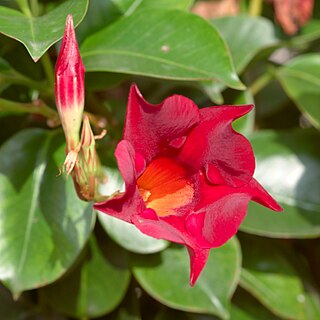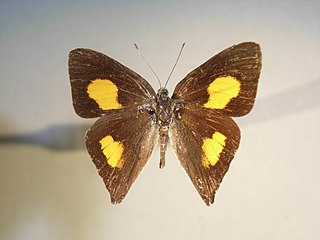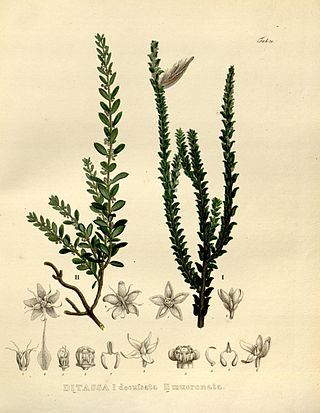
Psidium is a genus of trees and shrubs in the family Myrtaceae. It is native to warmer parts of the Western Hemisphere.

Mandevilla is a genus of tropical and subtropical flowering vines belonging to the family Apocynaceae. It was first described as a genus in 1840. A common name is rocktrumpet.

Cnidoscolus is a plant genus of the family Euphorbiaceae first described as a genus in 1827. The group is widespread across much of North and South America, including the West Indies.

Manihot is a genus in the diverse milkspurge family, Euphorbiaceae. It was described as a genus in 1754.

Dichorisandra is a genus of perennial monocotyledonous flowering plants in the dayflower family (Commelinaceae). It is found in the Neotropics. The genus is characterised by its slightly zygomorphic flowers with large anthers usually releasing pollen by means of pores at the apex, as well as by its seeds that are embedded in a red or sometimes white aril, and tubers that often form at the tips of the roots. Both morphology and an analysis of DNA sequences indicate it is very closely related to the genus Siderasis.

Vriesea is a genus of flowering plants in the botanical family Bromeliaceae, subfamily Tillandsioideae. The genus name is for Willem Hendrik de Vriese, Dutch botanist, physician (1806–1862). Its species are widespread over Mexico, Central America, South America and the West Indies.

Campomanesia is a genus in the family Myrtaceae described as a genus in 1794. It is native to South America and Trinidad.

Calycolpus is a genus of the botanical family Myrtaceae, first described as a genus in 1856. It is native to the South America, Central America, and the West Indies.

Aegiphila is a genus of flowering plants in the mint family, Lamiaceae, first described in 1763. It was formerly classified in the Verbenaceae. It is native to Mexico, Central America, South America, the West Indies, and Florida.

Syngonanthus is a genus of flowering plants in the family Eriocaulaceae. It is native to tropical Africa and to Latin America.
Streptostachys is a genus of South American plants in the grass family.

Olyra is a genus of tropical bamboos in the grass family. It is native primarily to the Western Hemisphere, with one species extending into Africa.
Otachyrium is a genus of South American plants in the grass family.

Euselasia thucydides is a species of metalmark butterfly, Riodinidae. It is found in Brazil. Subspecies thucydides is found in eastern Brazil, ranging from Santa Catarina to Bahia and the Zona do Mato in eastern Minas Gerais, while ssp. truncata ranges through the central Planalto in Goias south east to the Serra do Cipo and to north central São Paulo.

Actinocephalus is a genus of plants in the Eriocaulaceae, first described in 2004. The entire genus is endemic to Brazil. It was formerly regarded as part of the related genus Paepalanthus, but recent studies have suggested that the two groups are better separated.
Leiothrix is a genus of plants in the Eriocaulaceae. It is native to tropical South America.
- Leiothrix affinisSilveira - Minas Gerais
- Leiothrix amazonicaMoldenke - Pará
- Leiothrix angustifolia(Körn.) Ruhland - Bahia
- Leiothrix araxaensisSilveira - Minas Gerais
- Leiothrix arechavaletae(Körn.) Ruhland - Uruguay
- Leiothrix argenteaSilveira - Minas Gerais
- Leiothrix argyrodermaRuhland - southeastern Brazil
- Leiothrix arrectaRuhland - Minas Gerais
- Leiothrix barreirensisSilveira - Minas Gerais
- Leiothrix beckii(Szyszyl. ex Wawra) Ruhland - Minas Gerais, Rio de Janeiro
- Leiothrix celiaeMoldenke - Cerro Yutajé in Amazonas State of Venezuela
- Leiothrix cipoensisGiul - Minas Gerais
- Leiothrix crassifolia(Bong.) Ruhland - Minas Gerais
- Leiothrix curvifolia(Bong.) Ruhland - Minas Gerais
- Leiothrix cuscutoidesSilveira - Minas Gerais
- Leiothrix dielsiiRuhland - southeastern Brazil
- Leiothrix distichocladaHerzog - Bahia
- Leiothrix dubiaSilveira - Minas Gerais
- Leiothrix echinocephalaRuhland - Minas Gerais
- Leiothrix edwalliiSilveira - São Paulo
- Leiothrix flagellaris(Guill.) Ruhland - Minas Gerais
- Leiothrix flavescens(Bong.) Ruhland - Guyana, Venezuela, Brazil, Peru, Bolivia
- Leiothrix flexuosaSilveira - Minas Gerais
- Leiothrix fluitans(Mart. ex Körn.) Ruhland - Minas Gerais
- Leiothrix fluminensisRuhland - Rio de Janeiro
- Leiothrix fulgidaRuhland - Minas Gerais
- Leiothrix glanduliferaSilveira - Minas Gerais
- Leiothrix glaucaSilveira - Minas Gerais
- Leiothrix gomesiiSilveira - Minas Gerais
- Leiothrix gounelleanaBeauverd - Minas Gerais
- Leiothrix graminea(Bong.) Ruhland - Minas Gerais
- Leiothrix hatschbachiiMoldenke - Minas Gerais
- Leiothrix heterophyllaSilveira - Minas Gerais
- Leiothrix hirsuta(Wikstr.) Ruhland - eastern Brazil
- Leiothrix itacambirensisSilveira - Minas Gerais
- Leiothrix laniferaSilveira - Minas Gerais
- Leiothrix linearisSilveira - Minas Gerais
- Leiothrix longipesSilveira - Minas Gerais
- Leiothrix luxurians(Körn.) Ruhland - Minas Gerais
- Leiothrix mendesiiMoldenke - Minas Gerais
- Leiothrix michaeliiSilveira - Minas Gerais
- Leiothrix milho-verdensisSilveira - Minas Gerais
- Leiothrix mucronata(Bong.) Ruhland - Minas Gerais
- Leiothrix nubigena(Kunth) Ruhland - Minas Gerais
- Leiothrix obtusifoliaSilveira - Minas Gerais
- Leiothrix pedunculosaRuhland - Minas Gerais, São Paulo
- Leiothrix pilulifera(Körn.) Ruhland - eastern Brazil
- Leiothrix prolifera(Bong.) Ruhland - Minas Gerais
- Leiothrix propinqua(Körn.) Ruhland - Minas Gerais
- Leiothrix retrorsaSilveira - Minas Gerais
- Leiothrix rufula(A.St.-Hil.) Ruhland - eastern Brazil
- Leiothrix rupestrisGiul - Minas Gerais
- Leiothrix schlechtendalii(Körn.) Ruhland - Bahia
- Leiothrix sclerophyllaSilveira - Minas Gerais
- Leiothrix sinuosaGiul - Minas Gerais
- Leiothrix spergulaRuhland - Minas Gerais
- Leiothrix spiralis(Bong.) Ruhland - Minas Gerais
- Leiothrix subulataSilveira - Minas Gerais
- Leiothrix tenuifoliaSilveira - Minas Gerais
- Leiothrix tinguensisHerzog - Bahia
- Leiothrix triangularisSilveira - Minas Gerais
- Leiothrix trichopusSilveira - Minas Gerais
- Leiothrix trifidaSilveira - Minas Gerais
- Leiothrix vivipara(Bong.) Ruhland - Minas Gerais
Rondonanthus is a genus of flowering plants in the family Eriocaulaceae. It is endemic to northern South America.
Minaria is a genus of flowering plants in the family Apocynaceae, first described as a genus in 2006. They are native to Brazil and Bolivia in South America.

Ditassa is a genus of plant in the family Apocynaceae, first described as a genus in 1810. It is native to South America.

Vellozia is a plant genus in the family Velloziaceae, established in 1788.














